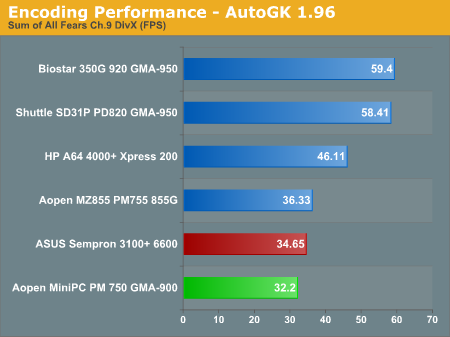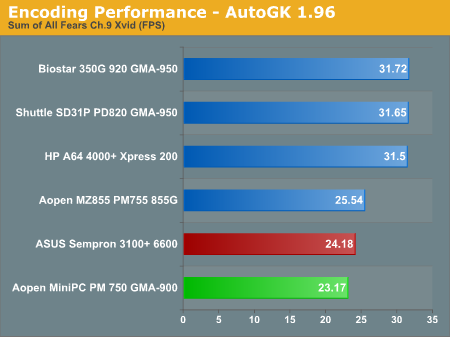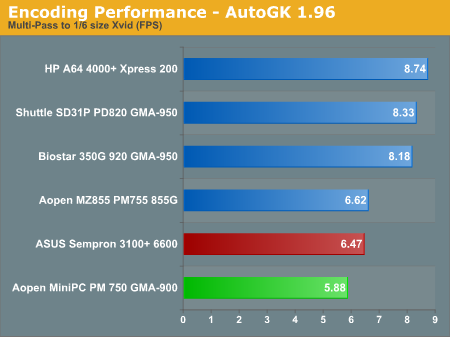Updated: AOpen MiniPC – Imitation is the Sincerest Form of Flattery
by Jarred Walton on March 3, 2006 12:05 AM EST- Posted in
- Systems
Encoding and Multimedia Benchmarks
Using AutoGK, we tested the multimedia encoding capabilities of the systems. For HTPC use, we tested the playback of several different video files as well and checked CPU use. For video playback, we used DVI as well as component output running 720p resolutions. We also tested performance connected to a Dell 2405FPW running at the native 1920x1200 resolution of the display, as video scaling can increase the load on the system for video content. The Pentium 4 506 chip had some issues during testing, so unfortunately, we didn't get AutoGK results with it.
DivX and Xvid encoding are good enough for casual use, but clearly, the Pentium M chip is not as fast as other platforms. Even the lowly Sempron 3100+ outpaces the Pentium M 740, though the margin is relatively close. Running a Core Duo processor would help quite a bit, but even that wouldn't catch up with Pentium D or Athlon X2 performance. For multimedia creation, the MiniPC is probably too slow for serious work. However, if you just want to encode the occasional video clip, letting the system process the file overnight will get the job done before you wake up in the morning. WMV9HD encoding is a different matter, but that's slow even on the fastest dual core systems.
Video Decoding
If you have a second PC doing the encoding work, the MiniPC works quite well as an HTPC. For video playback, there won't be any graphs, but I instead focused on the overall experience. Lower demand playback like MPEG-2 isn't even remotely a problem, so let's move on to the more demanding tasks.
Playing back 720p and 1080i content - even with scaling the video to fill the screen - worked without a hitch, with the CPU running a maximum of 50-80% load. (We'll talk a bit more about 1080i content later.) Every now and then, you might see a slight skip, most likely caused by another application using the hard disk, but otherwise, HDTV content worked fine. DivX and Xvid playback presented no difficulties either, with CPU load for both under 25% at typical (720x480) resolutions. DivXHD used more CPU time for the higher resolution, but playback still only used about 50% of the CPU power.
The other systems were all equal to the MiniPC or substantially better, but the bottom line is that for the currently most common video formats, all of the tested systems handled MPEG-2/HD/DivX/Xvid video playback with enough CPU power left in reserve that stutters shouldn't be a problem. Multitasking might present problems on the slower systems, of course, so we wouldn't recommend trying dual display output on the MiniPC with one display showing an HDTV stream, if you're trying to get work done, but few people really do that in our experience.
WMV9HD is a different story, but we've come to expect that from our most brutal video playback tests. 720p was okay, though it sometimes struggled (hitting upwards of 80% CPU usage); basically, it ran about as well as a 1080i HD transport stream. 1080p on the other hand was essentially unwatchable. Dual cores and even GPU acceleration are pretty much required to get completely smooth WMV9HD support for 1080p content; even a fast Athlon X2 or Pentium D will struggle with 1080p WMV9HD decoding, unless the GPU offloads some of the work. As nice as WMV9HD looks, it's difficult to justify the performance requirements at this time. DivXHD files encode and decode with much less CPU power, and file sizes are pretty comparable. As long as you stick to the other less CPU intensive codecs, the MiniPC will work fine.
Using AutoGK, we tested the multimedia encoding capabilities of the systems. For HTPC use, we tested the playback of several different video files as well and checked CPU use. For video playback, we used DVI as well as component output running 720p resolutions. We also tested performance connected to a Dell 2405FPW running at the native 1920x1200 resolution of the display, as video scaling can increase the load on the system for video content. The Pentium 4 506 chip had some issues during testing, so unfortunately, we didn't get AutoGK results with it.




DivX and Xvid encoding are good enough for casual use, but clearly, the Pentium M chip is not as fast as other platforms. Even the lowly Sempron 3100+ outpaces the Pentium M 740, though the margin is relatively close. Running a Core Duo processor would help quite a bit, but even that wouldn't catch up with Pentium D or Athlon X2 performance. For multimedia creation, the MiniPC is probably too slow for serious work. However, if you just want to encode the occasional video clip, letting the system process the file overnight will get the job done before you wake up in the morning. WMV9HD encoding is a different matter, but that's slow even on the fastest dual core systems.
Video Decoding
If you have a second PC doing the encoding work, the MiniPC works quite well as an HTPC. For video playback, there won't be any graphs, but I instead focused on the overall experience. Lower demand playback like MPEG-2 isn't even remotely a problem, so let's move on to the more demanding tasks.
Playing back 720p and 1080i content - even with scaling the video to fill the screen - worked without a hitch, with the CPU running a maximum of 50-80% load. (We'll talk a bit more about 1080i content later.) Every now and then, you might see a slight skip, most likely caused by another application using the hard disk, but otherwise, HDTV content worked fine. DivX and Xvid playback presented no difficulties either, with CPU load for both under 25% at typical (720x480) resolutions. DivXHD used more CPU time for the higher resolution, but playback still only used about 50% of the CPU power.
The other systems were all equal to the MiniPC or substantially better, but the bottom line is that for the currently most common video formats, all of the tested systems handled MPEG-2/HD/DivX/Xvid video playback with enough CPU power left in reserve that stutters shouldn't be a problem. Multitasking might present problems on the slower systems, of course, so we wouldn't recommend trying dual display output on the MiniPC with one display showing an HDTV stream, if you're trying to get work done, but few people really do that in our experience.
WMV9HD is a different story, but we've come to expect that from our most brutal video playback tests. 720p was okay, though it sometimes struggled (hitting upwards of 80% CPU usage); basically, it ran about as well as a 1080i HD transport stream. 1080p on the other hand was essentially unwatchable. Dual cores and even GPU acceleration are pretty much required to get completely smooth WMV9HD support for 1080p content; even a fast Athlon X2 or Pentium D will struggle with 1080p WMV9HD decoding, unless the GPU offloads some of the work. As nice as WMV9HD looks, it's difficult to justify the performance requirements at this time. DivXHD files encode and decode with much less CPU power, and file sizes are pretty comparable. As long as you stick to the other less CPU intensive codecs, the MiniPC will work fine.










54 Comments
View All Comments
plinden - Friday, March 3, 2006 - link
Yeah, when are we getting the ability to edit our posts?siliconthoughts - Friday, March 3, 2006 - link
When a genuine mac mini costs less, is more upgradeable (dual core, 2 DDR slots, digital audio, WiFi, Bluetooth, 4 USB ports, faster graphics) comes with a nifty secure OS and includes a whole suite of apps, why would anyone buy this? XP just isn't that great that I'd spend a $300 premium for it on an inferior box.Googer - Friday, March 3, 2006 - link
These are nice, but It is my suspicion that a Turon in an Mini PC would be the faster choice.NegativeEntropy - Saturday, March 4, 2006 - link
Agreed -- a Turion "version" would be interesting. That said, I think this statement from the review could use a bit of modifying:"...if you really want low power, you can go with one of the Pentium M platforms. End of discussion. "Tech Report recently found that the Turion can compete pretty well with the PM on power consumption http://techreport.com/reviews/2006q1/pentiumm-vs-t...">http://techreport.com/reviews/2006q1/pentiumm-vs-t...
JarredWalton - Saturday, March 4, 2006 - link
This isn't meant as a far-reaching statement. What I'm talking about is small form factors, or systems that will compete with the MiniPC. Turion support on socket 754 platforms is lacking, meaning that there are boards that support it but there are definitely boards that won't support it. Most of the socket 754 small form factors are pretty old, so I don't know how many of them would support Turion.The article at Tech Report is interesting, but idle power draw is only half of the question. 94 W at full load really isn't that much better than the rest of the Athlon 64 line. I mean, the HP DX5150 with an old ClawHammer core running at 2.4 GHz is only about 20 W higher. If you were to use a 90 nm Athlon 64, that would cut off 10 W or so right there.
Basically, the Athlon 64 design is really good, and it doesn't require all that much power. However, it still can't really compete with the Pentium M. when you shift to laptops, the whole system probably doesn't consume more than 45 W, so 20 W more for the processor is a major deal. Using desktop systems to try and determine laptop suitability is definitely not the best way to go about it. Ideally, you would want identical laptops, with the only difference being motherboard, chipset, and memory. But that's a story for another day.
Googer - Friday, March 3, 2006 - link
I would love to see this Aopen MINI PC rebench marked with a Pentium M 733 or 753 Ultra Low Voltage Processor that has a Maximum of 5W TDP! I would love to see it compaired against the higher 27W TDP Pentium M 740 in both Power Consumtion and Application benchmarks.I bet that at full load the power usage on full load will drop from 38W (with 740) down to 16w and even lower at IDLE! (10W maybe?) With a processor like that this would be the perfect pc for those guys who like to intergrate computers with their cars. Bye bye VIA C3! (C3 Will have http://www.metku.net/index.html?sect=view&n=1&...">other uses though)
JarredWalton - Friday, March 3, 2006 - link
Actually, with the HDD and other components, the system is probably using around 18W for the system and 7 to 20W for the CPU. It might even be 20-22W for the system. Still, 38W at maximum load (i.e. HDD activity along with 100% CPU) is hardly going to tax a car, I don't think. (But I'm not a car A/V guy, so maybe I'm wrong.)michael2k - Friday, March 3, 2006 - link
You would think, with AOpen's resources, that the AOpen MiniPC would be cheaper than the more powerful and featureful Mac mini.What is AOpen doing that is making it more expensive? It's got an older chipset, slower CPU, less USB ports, no rewritable optical drive, no bluetooth, and no wireless networking.
It's an odd day when buying a Mac is cheaper AND more powerful.
Questar - Friday, March 3, 2006 - link
AOpen isn't isn't a computer manufacturer, they are a board maker. What could they do to bring down the price of a system?jconan - Friday, March 3, 2006 - link
It's the economy of scale! Apple definitely has this contract manufacturing capacity considering its hardware/software business as well as its distribution channels. AOpen is just a manufacturing firm and is not in the software business to install an in house OS and plus it doesn't have sufficient sales offices out in the distribution side to push its wares. They have to rely on major OEMs to buy in bulk quantity to leverage prices with them.